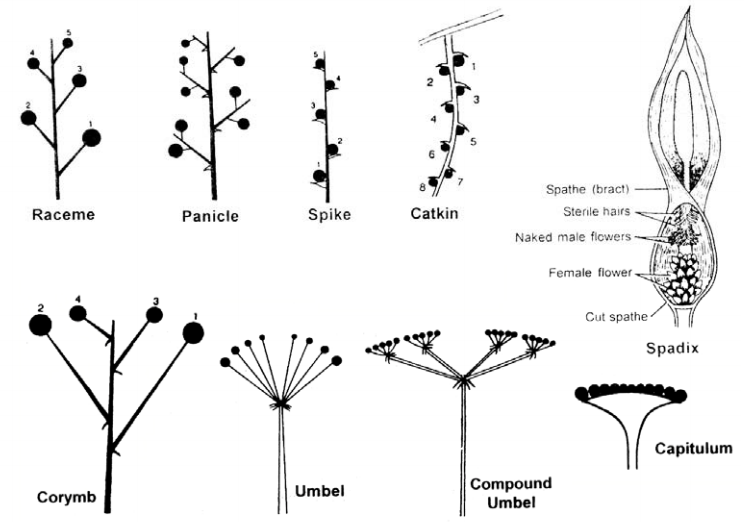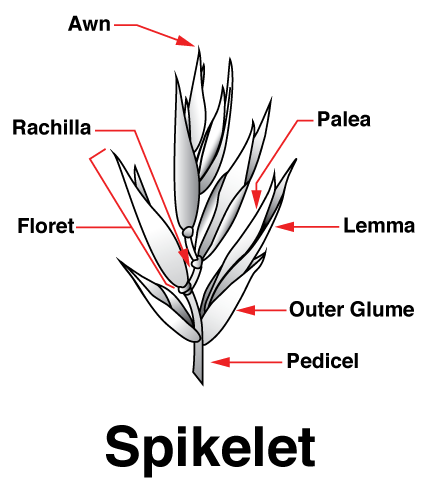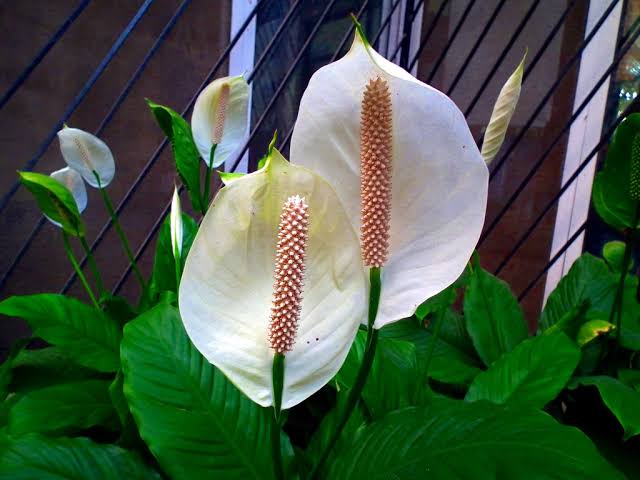“Racemose is a type of an inflorescence where the main axis continues to grow indefinitely and does not terminate in flower.”
This is why it is also known as an indefinite or indeterminate inflorescence.
Download the Complete Guide to NEET UG Prep
Download Now
Table of Content
- What is Inflorescence?
- Racemose Inflorescence
- Types of Racemose Inflorescence
- Characteristics and Examples of different racemose inflorescence
What is Inflorescence?
The apex of a plant produces different floral appendages at successive nodes. The arrangement of flowers on the floral axis is called an inflorescence. The inflorescence can be two types based on whether the apex continues to grow or not.
Types of inflorescence
- Racemose – Here, the flowers are supported laterally in an acropetal succession and the main axis continues to grow.
- Cymose – Here, the main axis terminates into a flower. Thus growth is limited.
Other types of inflorescence
Racemose and Cymose are the major inflorescence types. The other special types are –
- Compound Inflorescence – The main axis branches once or twice in a cymose or racemose manner.
- Cyathium – It has a highly reduced inflorescence. It contains a cup-shaped involucre formed by the fusion of 5 bracts.
- Hypanthodium – It has a flask-shaped receptacle forming a hollow cavity. Also, it has terminal pores surrounded by scales.
- Verticillaster – It is a special type of inflorescence seen in Lamiaceae. It is a condensed form of a dichasial cyme with sub-sessile or sessile flowers.
Racemose Inflorescence
The main characteristics of the racemose inflorescence are:
- Growth of the main axis (peduncle) is indefinite and continues to produce a flower bud
- The peduncle seldom terminates in a flower
- Peduncle is monopodial
- The first formed flowers are formed at the base of the peduncle
- Flowers are borne laterally in acropetal succession, i.e. older flowers are at the base and younger ones at the tip
- Group of flowers are arranged centripetally, i.e. younger flowers in the middle and older flowers at the periphery
- Newly formed fruits are not protected by flowers
- Grouping of flowers is less common
Recommended Video:

Types of Racemose Inflorescence

Types of Racemose Inflorescence
A. Elongated main-axis: The racemose inflorescence is divided into various types based on the branching, length of peduncle and presence or absence of pedicel (a small stalk that bears flower):
- Raceme
- Spike
- Spikelets
- Catkin
- spadix
B. Shortened main-axis:
- Corymb
- Umbel
c. Flattened main axis:
- Capitulum
Also see: Difference between Cymose and Racemose inflorescence
Characteristics and Examples of different racemose inflorescence
A1. Raceme: The main axis is unbranched, elongated and bears pedicellate flowers laterally in acropetal succession. The older flowers present at the base have longer stalk as compared to the upper younger flowers.
Examples: Brassica campestris (mustard), Raphanus sativus (radish), Crotalaria retusa (rattleweed), Cleome viscosa (Asian spiderflower), Antirrhinum majus (snapdragon), Convallaria majalis (lily of the valley), etc.
When the main axis of the inflorescence is branched and lateral branches bear flowers in a simple raceme manner, it is known as compound raceme or panicle.
Examples: Mangifera indica (mango), Azadirachta indica (neem), Delonix regia (Gulmohar), etc.
A2. Spike: The main axis is unbranched with unlimited growth as raceme but flowers are sessile, i.e. without pedicel, directly attached to peduncle without a stalk
Examples: Piper longum (long pepper), Acyranthes (chaff flower), Amaranthus (amaranth), Justicia adhatoda (Malabar nut), etc.
Compound spike is known as the spike of spikelets. Sessile flowers (spikelets) are present on the branched main-axis. Examples: wheat, barley, sorghum, oats etc.
A3. Spikelets:

- Spikelets are characteristic of the Poaceae family (Graminae, Grass).
- Individual flower units are called Spikelets
- The central axis of the inflorescence is called a rachis
- Spikelets have two scaly bracts present at the base called glumes
- Number of florets per spikelet vary in different species
- Each floret has no calyx or corolla
- Reproductive organs of the floret are enclosed by two bracts, the external larger one is called lemma and the interior smaller one is called palea
Spikelets can have raceme, panicle, spike or compound spike (spike of spikes) inflorescence
Raceme spikelet: Spikelets borne on pedicels and attached to rachis (central axis). Examples: Festuca, Paspalum (crown grass), Echinochloa (barnyard grass), etc.
Panicle spikelet: Spikelets are not directly attached to the rachis, instead are attached to panicle branches. Examples: Avena, switchgrass, reed canary grass, Alopecurus (foxtails), etc.
Spike spikelet: Spikelets are sessile and attached directly to the rachis or panicle branches (compound spike) without pedicel. Examples: Hordeum, ryegrass, Triticum aestivum (Wheat), etc.
A4. Catkin: It is a modified spike with a drooping central axis. It contains unisexual sessile flowers arranged closely on the peduncle. Flowers have inconspicuous petals and scaly bracts.
Examples: Morus alba (mulberry), Betula (birches), Qercus (oaks), Salix (willows), etc.
A5. Spadix: This is also a modified spike with a fleshy axis. It contains numerous sessile flowers arranged acropetally. The spadix is enclosed by leaf-like large, bright, colourful and curved bracts known as a “spathe”. Female flowers are present at the base, male and sterile flowers are present at the top. It is found in monocotyledons.
Examples: Present in the plants of family Araceae (arums), Musaceae, Palmaceae
In the compound spadix, the main axis is branched and each branch bears sessile flowers. The whole inflorescence is enclosed by one thick boat-shaped spathe. E.g. coconut
Examples: Caesalpinia (peacock flower), Iberis amara (candytuft)

Spadix in Anthurium
B1. Corymb: In this type of inflorescence peduncle is short with pedicellate flowers. All the flowers appear at the same level. The stalk of the lower flower is longer than younger upper flowers.
When the main axis is branched in a corymbose manner and each branch has flowers arranged in corymbs, it is known as a compound corymb.
Examples: Cauliflower
B2. Umbel: The main axis is shortened. The involucre of bracts (whorl) is present. Flowers arise from the axil of bracts. Each flower has pedicel of the same length, spread from a common point. It can be simple umbel or compound umbel, which is umbel with branches, also known as “umbel of umbels”. Umbel inflorescence is characteristic of the Apiaceae (Umbelliferae) family.
Examples: Simple umbel: Centella asiatica (Brahmi), Allium cepa (onion), Fatsia japonica (paper plant), Primula veris (cowslip), etc.
Compound umbel: Coriandrum sativum (coriander), Foeniculum vulgare (fennel), Daucus carota (carrot), Conioselinum pacificum (parsley), etc.
C1. Capitulum (Head): Capitulum is also known as racemose head. It is the most advanced inflorescence. It is characteristic of the Asteraceae (Compositae) family. The peduncle is short, flattened and broad. Flowers are called “florets”.
- Florets are sessile and arranged in a centripetal manner, i.e. outer flowers are older and inner flowers are younger
- Individual florets are bracteate
- The whole inflorescence is covered with one or more whorls of bracts (involucre)
- Florets may be unisexual, bisexual or sterile
- Florets are of two types, strap-shaped ray florets and central tubular disc florets
- If two types of florets are present in a capitulum, it is known as heterogamous
- If all the flowers of a capitulum are the same it is known as homogamous
Examples: Helianthus annuus (Sunflower), Zinnia, Tagetes erecta (Marigold), Cosmos, Mimosa pudica, Acacia, etc.
Also check:
- Important Notes Of Biology For NEET Plant Kingdom
- NEET Questions Plant Kingdom
- Flashcards for Plant Kingdom
Frequently Asked Questions
What is racemose inflorescence?
Inflorescenece is a type of arrangement of flowers around the floral axis. When the main axis does not terminate in a flower and continues to grow, it is referred to as racemose inflorescence.
Which plant shows Racemose inflorescence?
Some of the examples of plants with racemose inflorescence are mustard, snapdragon, gulmohar, wheat, barley, parsley, etc.
What is the difference between Racemose and Cymose?
The main difference between racemose and cymose inflorescence is in the location of flowers on the main axis. Flowers are borne laterally and the main floral axis shows indefinite growth in the racemose type, whereas in the cymose type, flowers are borne apically and the main floral axis shows definite growth.
Is umbel Racemose inflorescence?
Yes, umbel is a type of racemose inflorescence, wherein the main axis is shortened. Each flower has a pedicel of the same length, spread from a common point. E.g. parsley, dill, coriander, fennel, onion, etc.
Is Racemose acropetal?
Yes, the arrangement of flowers is acropetal in racemose inflorescence, i.e. younger flowers or buds are present at the top and older flowers are present at the bottom. In a group of flowers, the arrangement is centripetal, i.e. younger flowers are present in the middle and the older flowers are present towards outside.
Also Check:
NEET Flashcards: Plant Kingdom
NEET Flashcards: Morphology Of Flowering Plants
NEET Flashcards: Anatomy Of Flowering Plants

Helpful for study
Very good explanation of inflorescence
I highly appreciate your effort. Because this was super supportive for one of my assignments. Thanks a lot.